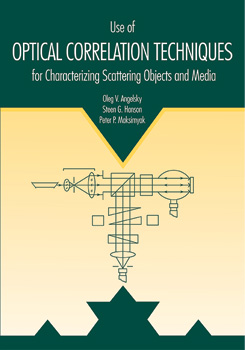Proceedings Article | 4 March 1999

KEYWORDS: Fractal analysis, Diagnostics, Surface finishing, Diffraction, Photodetectors, Spatial frequencies, Polarization, Surface roughness, Mirrors, Modulators
Most of the objects to be found in nature are essentially random, i.e. affecting the probing optical radiation they transform its amplitude and phase parameters in complex, hardly predicted manner. Traditionally, such objects are described in the framework of the theory of probability and mathematical statistics. In last decade, however, the novel approach is outlined according to which rather extensive class of natural and artificial objects can be represented as any mixture of deterministic and random spatial structures. The fractals, i.e. the objects possessing the feature of structural self-similarity in the strict or in any generalized sense, are the most adequate model describing such objects'. Interaction of these objects with a coherent radiation results in stochastic spatial structures. Here we consider some techniques Lor structural diagnostics of an object that are based both on the probabiitic approach 'and on the stochastic one. Speaking about random optical fields, we will imply spatially inhomogeneous stationary fields resulted from interaction of coherent radiation with random phase or amplitude objects. One encounters such a speckle field solving the problem of remote structural diagnostics of an object. Besides, we will limit our consideration with the scalar approximation. Surface roughness is often considered as the classic model of the object causing spatial modulation of the probing beam. On the one hand, it is easily to prepare such an object with the independently controlled parameters. On the other hand, the diagnostical problem is of the most practical importance for the objects of this kind. That is why, we will illustrate the capabilities of the optical correlometric techniques using a rough surface as the basic model, as a rule. At the same time, amplitude and phase deterministic or quasi-deterministic objects will be also under our consideration, and the fractals whose main feature consists in their structural self-similarity' will be the most significant examples of these objects. It is well known, that genera! solution of a statistical diagnostica! problem consists in reconstruction of the height distribution function for a rough surface inhomogeneities or, alternatively, in finding out the complete set of the statistical moments characterizing the object's structure. If the object is assumed to be random in the strict sense, then its description in terms of a height distribution function or in terms of a complete set of the statiical moments represents comprehensive solution of the rtatistica! diagnostical problem. In practice, however, necessity in such a general statistical description occurs to be rather rare. In accordance with the well known statements of mathematical statistics, knowing of several low-order statistical moments is enough for characterization of the object under study in its significant features and in desirable approximation. In the case of rough surfaces, the correlation length and root-mean-square (rms) of roughness from the mean surface line (that is linked by simple relation with a phase variance of the boundary field in some practically important cases) are the main statistical parameters adopted for rough surface characterization. As any simple model for surface roughness is used, particularly, by presuming Gaussian or another symmetrical height distribution function, the diagnostical problem is solved in principle by determining these parameters through any of the known high efficient techniques2. For all that, the question arises: if the experimentally found parameters are corresponding with desirable accuracy to the intrinsic roughness parameters? In other words, the problem of adequacy of the used model for a rough surface arises. It is stated in some recently reported studies that the fractal model occurs to be adequate for rough surface characterization in numerous practical applications23. So, particularly, for a machined surface finish such a conclusion is grounded in Ref.2 . It is not less important, attraction of the approaches of a chaos theory as well as fractal optics methodology enables to extend the circle of the problems of rough surface diagnostics that can be solved in the framework of the unified approach, irrespective of the phase variance at the boundary field. Of course, in the framework of this approach, the solution of a diagnostical problem is formulated in unconventional terms, such as chaos dimension closely related to the notion of entropy. The diagnostically important interconnection among the dimension parameters of the scattered optical radiation and the corresponding dimension parameters of the object's structure is found. Somewhat (to say, in the mentioned above surface finish problem) unambiguous interconnections occur to be put in evidence among these (dimensional) parameters with the traditional ones, such as the standard deviation of the surface profile from the mean surface line and the correlation length of surface inhomogeneities2. This paper is devoted to consideration of the present state of the problem briefly outlined above and interrelations among different mentioned approaches.



